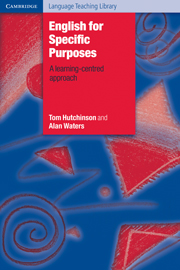2 - The development of ESP
Published online by Cambridge University Press: 03 May 2010
Summary
The best laid schemes o’ mice and men Gang aft a-gley.
(Robert Burns)From its early beginnings in the 1960s ESP has undergone three main phases of development. It is now in a fourth phase with a fifth phase starting to emerge. We shall describe each of the five phases in greater detail in later chapters, but it will provide a useful perspective to give a brief summary here. It should be pointed out first of all that ESP is not a monolithic universal phenomenon. ESP has developed at different speeds in different countries, and examples of all the approaches we shall describe can be found operating somewhere in the world at the present time. Our summary must, therefore, be very general in its focus.
It will be noticeable in the following overview that one area of activity has been particularly important in the development of ESP. This is the area usually known as EST (English for Science and Technology). Swales (1985) in fact uses the development of EST to illustrate the development of ESP in general:
‘With one or two exceptions…English for Science and Technology has always set and continues to set the trend in theoretical discussion, in ways of analysing language, and in the variety of actual teaching materials.’
We have not restricted our own illustrations to EST in this book, but we still need to acknowledge, as Swales does, the pre-eminent position of EST in the ESP story.
Information
- Type
- Chapter
- Information
- English for Specific Purposes , pp. 9 - 15Publisher: Cambridge University PressPrint publication year: 1987
Accessibility standard: Unknown
Why this information is here
This section outlines the accessibility features of this content - including support for screen readers, full keyboard navigation and high-contrast display options. This may not be relevant for you.Accessibility Information
- 3
- Cited by
